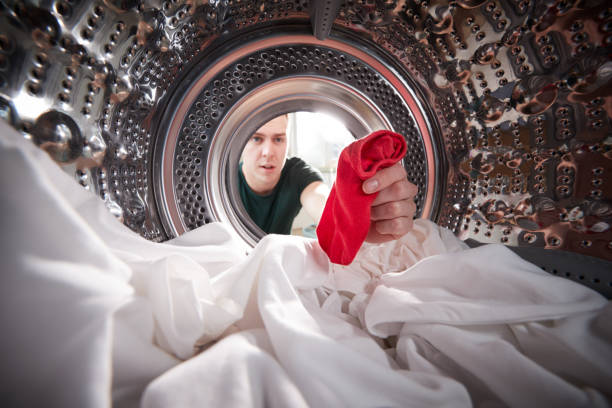It’s not uncommon for people to inadvertently damage their clothes during the laundry process. Understanding the most common laundry mistakes can help you avoid mishaps and ensure your garments remain in great condition. Here, we’ll identify seven typical errors and provide tips to evade them.
Sorting Laundry Incorrectly

One of the most fundamental steps in laundry is sorting clothes correctly. Failing to separate colors can lead to dye transfer, where bright colors bleed onto lighter fabrics. It’s also vital to sort by fabric type and weight. Mixing heavy items with delicate ones can cause damage due to the friction and differing drying times. To avoid these issues, separate your laundry by color, fabric type, and weight before washing.
Using Too Much Detergent
While it may seem like more detergent equals cleaner clothes, this is a common misconception. Excess detergent can leave a residue on garments and in the washing machine. This residue can make clothes appear dulled, and over time, it can trap dirt and bacteria. To prevent this, always measure detergent according to the load size and soil level, using the recommendation on the detergent label.
Ignoring the Care Label
Every garment comes with a care label, which is a small tag that provides crucial cleaning instructions. Ignoring these labels can lead to shrinkage, color fading, and fabric damage. For example, wool should typically be hand-washed or dry-cleaned, while cotton can handle a hotter wash. By adhering to the instructions on the care labels, you will extend the lifespan of your clothing.
Overloading the Washing Machine
Packing too many clothes into the washing machine at once may save you time, but it’s detrimental to your laundry. Overloading prevents proper circulation of water and detergent, leading to ineffective cleaning and more wear on fabrics. It can also put a strain on the machine itself. For the best results, follow the manufacturer’s load capacity guidelines.
Not Using the Right Washer Settings
Modern washing machines come with a variety of settings tailored to different types of laundry. Using the wrong settings can damage clothes by exposing them to inappropriate temperatures or spin speeds. For instance, delicate fabrics should be washed on a gentle cycle, while heavily soiled items might require a more intensive wash. Take the time to choose the correct settings for each load to preserve the integrity of your garments.
Failing to Pre-treat Stains
Throwing stained clothes directly into the wash without pre-treating them can make the stains harder to remove. Some stains become permanent if not properly treated before washing. To handle stains effectively, apply a stain remover or a bit of detergent directly onto the stain and let it sit for a few minutes before washing. Ensure you follow the instructions on the stain remover for optimal results.
Poor Drying Practices
Improper drying methods can also wreak havoc on clothing. High heat can cause shrinkage, while over-drying can weaken fibers and lead to harsh, brittle fabrics. Air drying is often the best method for delicate items. If using a dryer, select the appropriate heat setting and avoid overloading to ensure even drying. Using dryer balls can also help reduce drying time and prevent static cling.
Conclusion
In conclusion, avoiding common laundry mistakes is key to maintaining the lifespan and quality of your clothes. By sorting laundry correctly, using the right amount of detergent, adhering to care labels, not overloading the washing machine, using the correct settings, pre-treating stains, and employing proper drying techniques, you can keep your garments looking fresh and new. Paying attention to these details will save you time, money, and preserve your favorite outfits.
FAQs
1. Can I wash all my clothes in cold water?
While cold water is generally safe for most fabrics and helps prevent shrinkage and color bleeding, some heavily soiled clothes or oily stains may require warm or hot water for effective cleaning. Always check care labels for specific washing instructions.
2. What happens if I ignore the care labels?
Ignoring care labels can lead to various problems such as shrinkage, fading, and fabric damage. Following the instructions on the care labels is essential for maintaining the appearance and durability of your garments.
3. How do I prevent color bleeding in the wash?
To prevent color bleeding, always separate dark, light, and brightly colored items. Washing new clothes separately the first few times can also help prevent dye transfer. Using cold water can further reduce the risk of colors bleeding.
4. Can I use regular detergent for delicate fabrics?
It’s better to use a detergent specifically designed for delicate fabrics or hand-wash items like silk or wool. Regular detergents can be too harsh and may damage fragile fibers. Always opt for a gentle formula for delicate pieces.
5. How can I avoid overloading my washing machine?
Refer to your washing machine’s user manual for load capacity guidelines. When loading the machine, make sure there is enough room for water circulation, typically filling the drum about three-quarters full.
